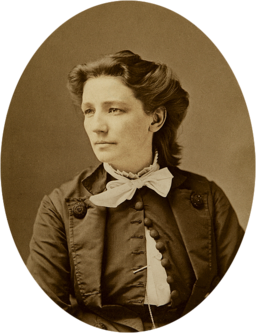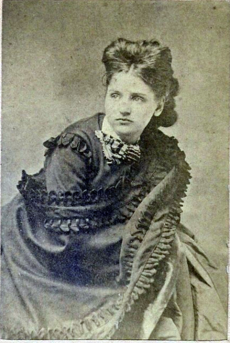|
By Laurie Lewis If you’ve watched the Democratic debates, you may have been struck by the number of women contending for President of the United States. Perhaps you’ve credited Hillary Clinton for opening the door for women in a previously men-only club. In fact, Clinton was not the first woman to enter the presidential race. That was Victoria Woodhull (1838-1927)--who threw her hat in the ring almost fifty years before women could vote. Victoria Woodhull Photo by Mathew Brady, c. 1870 Victoria Woodhull, nee Claflin, was the child of ne’er-do-wells. Her father put her and her younger sister Tennessee (known as Tennie) on the family’s traveling circuit—“circus” would be a better description—as clairvoyants and child preachers. No wonder the older daughter thought marriage at the age of fifteen would be a better alternative! But her husband, Canning Woodhull, was abusive, and she divorced him two children and eleven years later. That was a daring act, as divorce was scandalous in those days. But Victoria Woodhull was a proponent of free love who believed, among other things, that a woman should have the right to leave a bad marriage. She exercised that right more than once. In 1866, she married Colonel James Blood, a spiritualist who also believed in free love; they divorced ten years later. With her second husband, her children, and her sister, Victoria Claflin Woodhull moved to New York City in 1868. The two women resumed their childhood trade, working as spiritualists and clairvoyants. Before long, the sisters met the much older and extremely wealthy Cornelius Vanderbilt, who may have been a client in their psychic business. Vanderbilt was smitten with the lovely Tennie and appreciative of Victoria’s gutsiness. He urged them to go into a different type of business, where their clairvoyant powers would come in handy. Tennessee Claflin Photo by Geo. Stinson & Co. (date unknown) With backing from Vanderbilt, the sisters opened Woodhull, Claflin and Co., Wall Street’s first woman-owned brokerage firm, on February 5, 1870. The curious came by to see if the brokerage business was real; after all, women belonged at home in those days. Some men and many women—ranging from society wives to high-priced call girls with money to invest—became clients, and the firm prospered. With their brokerage company profits, the sisters started another venture, a newspaper called Woodhull & Claflin's Weekly. Like finance, publishing was a men-only profession. Their newspaper was an outlet for the women’s controversial ideas, giving voice to their support of free love, spiritualism, Marxism, and women’s rights. Victoria Woodhull was so strong an advocate of equal rights for women that she decided to run for President in the 1872 election. Like everything she did, her presidential bid was filled with challenges to societal norms. The most obvious was that women were barred from voting, so how dare one seek elected office! Woodhull wasn’t thirty-five years old yet, the minimum age for President. She appeared on the new Equal Rights party ticket, and her running mate was abolitionist Frederick Douglass—although he never acknowledged the nomination. Finally, even if women were allowed to vote in 1872, Victoria Woodhull couldn’t because she was in jail. Woodhull’s outspokenness eventually alienated her from others in the two main equal rights movements of the day, which sought equality for women and for African Americans. Although women’s suffrage advocates initially embraced her, Susan B. Anthony and other leaders later distanced themselves because she was too radical for their tastes. Popular Brooklyn preacher Henry Ward Beecher, an ardent abolitionist, became the target of Woodhull when her newspaper published a story about his affair with a parishioner. The story appeared a few days before the 1872 election and led to Woodhull and Claflin being arrested on charges of obscenity. That is how the first woman to run for President spent Election Day when she was on the ballot in jail. Five years later, Victoria Woodhull found herself starting over. Her second marriage had ended, her newspaper had folded, and the nation had seemingly abandoned her. With the one person she could count on, her sister Tennie, Woodhull moved to England. She continued to write and lecture there and married for the third time; this marriage ended with the death of her husband many years later. Settling down in England after leading such an extraordinarily bold life in New York, Woodhull apparently lost her fire—this woman who dared to go where no woman had before. (To read about other women of the period who challenged the status quo, see “Rebel Women of New York” in our August 2018 newsletter.) February Tours Most Take a Walk New York tours cover 1 to 2 miles, last 2 to 2½ hours, and cost $25 per person. Advance registration is required. To register and to learn the meeting place, email the guide ([email protected]). Please arrive a little before the start time. Tours are cancelled if nobody has registered or if the weather is extreme; if in doubt, call or text Laurie (917-306-2868). Central Park: Highlights of the Southern Half In the popular southern half of Central Park, you’ll recognize some of the most filmed and photographed sights in New York, including Strawberry Fields, the Sheep Meadow, and Bethesda Terrace. The park beckons in all kinds of weather. In winter, you clearly see some design elements that are hard to detect in other seasons through the foliage and visiting crowds. Take a walk through the southern half of Central Park on Saturday, February 1, at 1 PM. We’ll cover as much ground as weather permits. Please email the guide ([email protected]) to register and to learn the meeting location. Hidden Treasures of the Financial District Walking through the canyons of Wall Street, you can easily miss gems hidden in plain sight, including relics of the Dutch and English colonial periods and park-like oases. Discover these secrets while seeing major attractions like the New York Stock Exchange and the Charging Bull statue. You’ll realize that the Financial District has a lot more going for it than stock trades and megadeals. Laurie offers this tour on Sunday, February 16, at 1 PM. To reserve a spot on the tour and to learn the meeting location, email her at [email protected]. Mansions of Fifth Avenue You can still find magnificent mansions built about a hundred years ago on the Upper East Side. These freestanding and rowhouse mansions are interspersed among luxury apartment buildings—mansions in the sky. Hear about these palatial homes and the people who lived in them—New York City’s own rich and famous. Laurie gives this tour on Saturday, February 29, at 1 PM. To reserve a place and to learn the meeting location, email her at [email protected]. February Tours
|
Archives
April 2024
|



